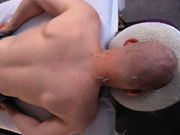Over 41 percent of U.S. adults with musculoskeletal pain disorders use complementary health approach
MONDAY, Oct. 17, 2016 (HealthDay News) — Use of complementary health approaches is significantly higher for U.S. adults with musculoskeletal pain disorders, according to a report published online Oct. 12 in the U.S. Centers for Disease Control and Prevention’s National Health Statistics Reports.
Tainya C. Clarke, M.P.H., Ph.D., from the National Center for Health Statistics in Hyattsville, Md., and colleagues used data from the 2012 National Health Interview Survey to examine the use of complementary health approaches among U.S. adults with musculoskeletal pain disorders.
The researchers found that 54.5 percent of U.S. adults had a musculoskeletal pain disorder in 2012. The use of any complementary health approach for any reasons was significantly higher for those with versus those without a musculoskeletal pain disorder (41.6 versus 24.1 percent). Use of natural products was significantly higher than use of mind and body approaches, practitioner-based approaches, or whole medical system approaches (24.7 versus 15.3, 18.2, and 5.3 percent, respectively) among adults with any musculoskeletal pain disorder. Although this pattern was similar for those without musculoskeletal disorders, the prevalence was significantly lower for those without versus those with a musculoskeletal disorder. The use of practitioner-based approaches for treatment was more than three times as high as the use of any other group of approaches (9.7 versus 0.7 to 3.1 percent) for those with musculoskeletal disorders.
“This report adds to evidence regarding the use of complementary approaches to treat or manage pain in the U.S. population,” the authors write.
Full Text
Copyright © 2016 HealthDay. All rights reserved.








